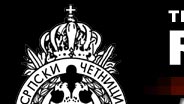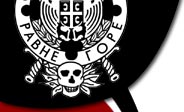Sources
used in this text are from the war archives of Dinara Chetnik
Division.
The
first call to arms in occupied Europe issued by the future
leader of the Third Serbian Uprising, General Dragoljub
Draza Mihailovic, quickly spread throughout Serbian lands
including Montenegro, Hercegovina, eastern and central Bosnia
and the border area of Bosnia, Lika and Dalmacia.
This
text will mostly be concerned with the uprising of July
27, 1941, and the subsequent formation of the Dinara Chetnik
Division in the village of Crni Potoci. The commander of
the Dinara Chetnik Division was Duke Momcilo R. Djujic (born
in the village of Topolje near Knin in 1907- died in San
Marcos, California in 1999), a famed leader and later one
of the bravest Serbian commanders under the authority of
General Mihailovic.
After
the fall of Yugoslavia, the Nazis created the Independent
State of Croatia which included much of the traditional
Serbian land. After its formation, Germans gave nominal
control of this creation to the vicious Croatian Nazis called
Ustasa. Ustasa put forward a plan that would lead to the
complete eradication of the Serbian people west of the river
Drina. So, in the first weeks of existence of the Independent
State of Croatia, tens of thousands of Serbs were slaughtered
in the most brutal ways. This forced Serbian people to form
a spontaneous, unorganized resistance movement. Local leaders
spontaneously started organizing people into small fighting
units. These units had to individually arm themselves and
seek help wherever they could.
In
the Serbian lands included in the Independent State of Croatia,
Chetnik resistance developed under different circumstances
and had a different character from the resistance in Serbia
itself. While in Serbia resistance sprang up as a libratory
movement, the primary goal of the Serbian resistance in
the Independent State of Croatia was physical preservation
of the Serbian people from complete genocide conducted by
the Ustasa. That is the main difference between the resistance
movements in Serbia and Montenegro and those in the Serbian
land incorporated in the Independent State of Croatia.
In
the early part of 1942, General Mihailovic accepted all
of the Chetnik units in Montenegro, Bosnia and Hercegovina
and Dalmacia under his command. These units were desperately
trying to protect Serbian people from the complete eradication
by Croats, Muslims and later, communists.
In
the beginning, the Dinara Chetnik Division was made up of
several regiments: King Peter The Second Regiment in Lapac,
Petar Mrkonjic Regiment in Plavno, Gavrilo Princip Regiment
in Grahovo, King Aleksandar The First Regiment in Bosanski
Petrovac, Onisim Petrovic Regiment in Dalmatinsko Kosovo
and Vozd Karadjordje Regiment in Gracac .
The uprising started in the Bosnian city of Drvar and later
spread to hundreds of places on the border area of Bosnia,
Lika and Dalmacia. After Drvar, the resistance fighters
managed to quickly liberate Bos. Petrovac, Srb, Gracac,
Bos. Grahovo, and areas around Knin. The Chetnik resistance
fighters liberated most of the western Serbian lands. The
liberation brought much needed relief to the suffering Serbian
people.
Chetnik
fighters showed unprecedented courage during four years
of struggle for the protection of Serbian people from vicious
attacks of the monstrous Croatian Nazi formations. Heroic
Dinara Chetnik Division was made up of the heroic fighters
whose ancestors have, for centuries, been living at the
crossroad of the east and the west, and fought against the
occupiers coming from both directions.
The
uprising was carried out in the tradition of the Serbian
Chetnik liberation struggle. Serbian Chetniks lived by the
code of defending their own and never taking somebody else's,
the code that taught them to lead honorable and honest lives.
This code enabled them, with faith in God and victory, to
go freely into the battle and die in that battle because
freedom of their people was above everything. This code
is reflected in a single inscription on the flags they carried:
WITH FAITH IN GOD, FOR KING AND COUNTRY! FREEDOM OR DEATH!
Under these flags they overcame a great evil and defeated
a much stronger enemy.
Communist Plan for the Destruction of
the Dinara Chetnik Brigade
Arrival of the Red Army in the eastern Serbia on September
22, 1944, brought a twist for all the fighting sides in
the former Yugoslavia. This was especially true for the
communist forces (partizans) whose only goal was the imposing
of the Soviet style communist regime. With the arrival of
the Red Army it becomes clear that General Mihailovic and
the whole Serbian people were being put in a very difficult
position. The last blow came from Churchill, who buy rejecting
Mihailovic, drastically changed the power balance in Serbia
and Yugoslavia.
Communists,
who received an infusion of fresh forces by accepting fleeing
Croatian Nazis, started to move considerable forces into
the region around Knin and on the border of Bosnia, Lika
and Dalmatia. Their goal was surrounding the Dinara Chetnik
Division and its complete destruction.
Meeting
In The Village Of Topolje By Knin
These were hard and trying days for the Dinara Chetnik Division,
filled with heavy fighting and efforts to find a way out.
Communists were bringing fresh troops equipped with heavy
weaponry given to them by the ex-Chetnik allies, the British.
In the midst of heavy fighting, the commander of the Dinara
Chetnik Division, Duke Momcilo Djujic, called in all of
his commanders for a meeting in the village of Topolje by
Knin. At this historic meeting, everybody agreed on a course
of action that involved penetration through the communist
lines and strategic retreat toward the northwest.
Penetration
Of The Communist Blockade
The
final battle for the penetration through the communist blockade
took place in the village of Padjene. On the night between
December 2 and 3, 1944, Chetnik forces made the final attack.
In the titanic struggle that lasted more then seven hours
and took numerous casualties on both sides, Chetnik forces
smashed the communist blockade and opened a safe passage
for a tactical retreat. In this battle, outnumbered Chetnik
forces defeated far superior communist forces under the
command of Tito's elite generals--Bosko Siljegovic and Petar
Drapsin.
Many
chetniks from the Dinara Chetnik Division gave their lives
in this battle as a guarantee for the freedom of their posterity.
They died in the same location they started the uprising
in 1941. Their posterity will not forget their love and
sacrifice for the Serbian people.
Exile
And Suffering
After breaking through the communist blockade, the Dinara
Chetnik Division continued marching following the route
of Otric-Srb-Mala Kapela-valley of Gacko, towards the northern
Adriatic coast. In these areas the Croatian Nazis, Ustase,
committed horrendous crimes on the Serbian civilians. Not
even women, children or the elderly were spared. Together
with the fighters of the Dinara Chetnik Divisions, a great
number of women, children and elderly took up this voyage,
not wanting to stay under upcoming communist tyranny. People
in the columns were hungry and exhausted which made the
troops move very slowly along this treacherous route. There
were many challenges along the way that had to be overcome.
The greatest challenge was the crossing of the river Korana.
In order for the civilians to cross safely, improvised bridges
had to be constructed out of horse carriages and carts.
This took a lot of effort and skill. The cold river took
its own toll, drowning several fighters and their horses.
Those who safely crossed the river were greeted by the enemy
ambushes on the opposite shore.
The
retreat to Slovenia was undertaken because of the widespread
belief that the allies would not give Yugoslavia up to the
absolute power of the communists. From some unofficial remarks
by Colonel MacDaual (an American officer sent to establish
communications with the Chetniks), one could conclude that
the western allies would quickly shift their policy toward
Tito and his communist regime.
The
Road Without Return
After conquering the eastern parts of Yugoslavia, the communists
sent strong forces to Slovenia in order to destroy the Dinara
Chetnik Division and other Serbian National Forces stationed
in the area. All the anticommunist forces gathered in the
Vipava Valley in northern Slovenia. Their intention was
to cross the Soca River and go to Italy where they would
meet English and American forces. In order to achieve this
goal, the Chetniks had to stop advances of the communists
and destroy the remains of the Italian fascists stationed
in Gorica. The Chetniks succeeded in capturing the key bridge
on the Soca River. This ensured a safe passage for the soldiers
and civilian population alike. After the crossing, the bridge
was destroyed in order to stop communist advances. From
this moment the Dinara Chetnik Division found itself in
exile.
March
To Palma Novi
After crossing into Italy, Chetnik forces were directed
to march to Palma Novi where they were temporarily placed
in a newly constructed camp. On the Feast of St. George's
(May 6) Chetniks stationed in Palma Novi received a direct
order to turn over all of their weaponry. Throughout Serbian
history, the Feast of St. George marks the time of year
when the patriots, whenever under occupation, gathered and
armed themselves. This time they were forced to give up
the weaponry they paid for with their own blood. This tragic
day brought several suicides among the fighters who could
not stand this grave injustice.
Palma
Novi marks the end of the war road for the heroic Dinara
Chetnik Division.
A
Few Words In The End
Serbian fighters used their own blood and bones to mark
the borders of Serbian lands. Bravery is the characteristic
of all Serbian fighters from all Serbian lands in their
struggle for the cross and freedom. This is the road Serbian
fighters will continue to follow until all of the occupied
Serbian lands are liberated and Serbian people can return
to their ancestral dwellings. All of the suffering and injustices
from the past are reminders for the coming generations.
Toward
the end of his long life journey, the late Duke Momcilo
Dujic said, "We are proud of all Serbian fighters who
gave their lives for the cross and freedom of our people,
and of those innocent civilians who died simply because
they were Serbian and Orthodox Christians. Let God have
mercy on their lives in the Kingdom of God and let their
memory live internally among Serbian people."
In
the end, we would like to dedicate these lines to the memory
of the commander of the Dinara Chetnik Division, Duke Momcilo
Djujic and all of his fallen heroes who gave their lives
in the defense of Serbian lands. Dinara stands proud of
its mountain king and his heroes, and as long one can here
a cry from Serbian people, DINARA WILL NOT REST UNTIL THEY
ARE FREE.



